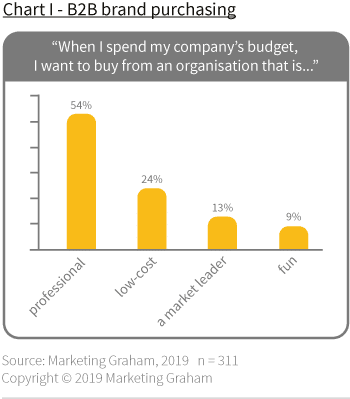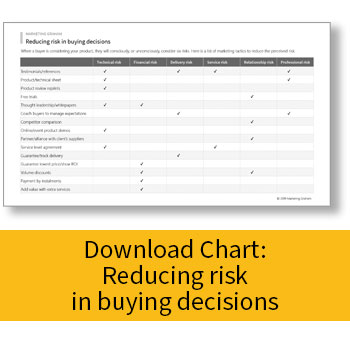When purchasing for ourselves, we want value for money, but we also want to enjoy the experience. We may want an element of fun. Buying for our company is different.
Consumer marketing (B2C) recognises that including humour in its advertising, marketing and branding can have benefits. The mistake comes when executives believe the same fun elements will maximise response in business-to-business (B2B) marketing. They don’t.
We might be prepared to buy from a clown when spending our own money, but not when spending our company’s money. There is too much at risk.
How risk influences your B2B brand
In another article titled “Purchases for yourself are different from purchases for your company“, I explore risk and its impact on purchasing decisions and the buying team. In this article, I will explore how it influences the marketing message.

I believe that risk affects the type of B2B brand buyers choose. To provide more evidence for my view, I asked over 300 executives what kind of brand they buy when spending company money. The choice was a brand that looked professional, fun, low-cost or a market leader. The result is in Chart I.
As you can see, when spending their department’s budget, executives are least likely to buy from a ‘fun’ organisation.
Fun may get you noticed, it may get you Likes and Shares on social media, but it seems less likely to get you a signature on the contract.
Because of risk, buyers voted overwhelmingly for an organisation that appears to be professional. They even prefer that to a low-cost company or a market leader.
Often the suggestion that your marketing should be more fun comes from your colleagues. This is usually driven by the fact that staff at your organisation have a much higher exposure to your marketing – and therefore get bored with it very quickly. The solution they propose is… fun!
The usual (or most accessible) reference point for staff wanting to add fun is to quote humorous TV commercials. You may have smiled at some of the adverts below…
But your target audience does not have the same exposure to your marketing (so they don’t get bored) and also have a different need (they want a safe pair of hands). Your new customers are looking for someone professional that can limit the risks of appointing a supplier.
How the need to reduce risk influences your marketing message
When a buyer is considering your product, they will consciously, or unconsciously, consider six risks.
- Technical risk. Will the product perform as expected?
- Financial risk. Does it represent value for the money? Could we get it cheaper?
- Delivery risk. Will the delivery be on time and in good order?
- Service risk. Will the product be supported without delay?
- Relationship risk. How will working with the new supplier affect other commercial relationships?
- Professional risk. How will it affect my professional standing, career and personal development?
You can download my chart ‘Reducing risk in buying decisions‘ which shows examples of what you can do to reduce the perceived risk.
Consumer marketing can be very different from marketing to a company. One significant difference is that people are not spending their own money when they make a company purchase. So if your marketing makes you look like a clown, they will think twice before ordering.
Get my latest blog posts, reports and videos delivered straight to your Inbox, just 8 times a year. It’s free but not cheap. Complete the form below to receive the Marketing Graham Bulletin; you can unsubscribe at any time.
| Marketing Graham Bulletin |
|---|





